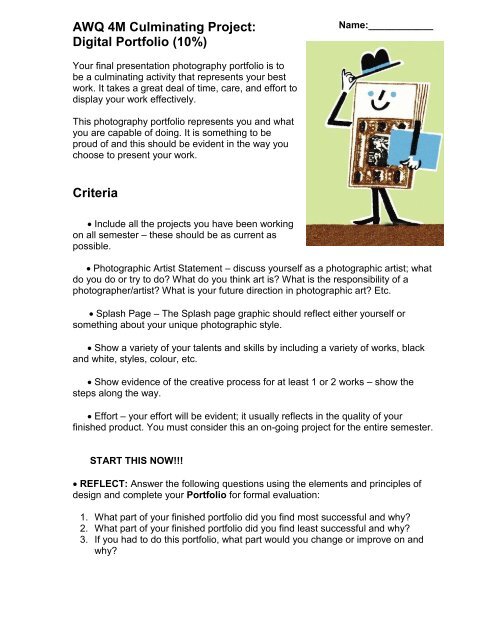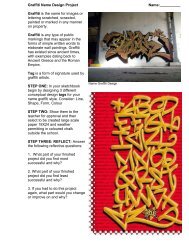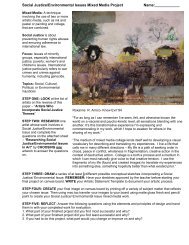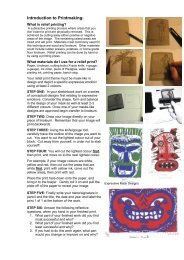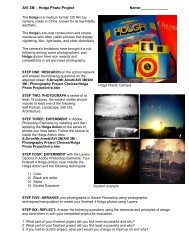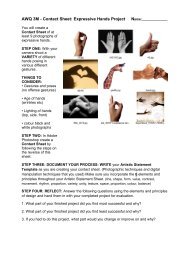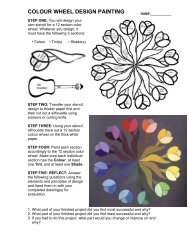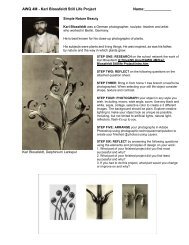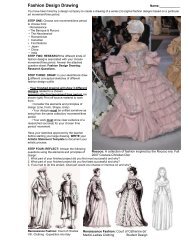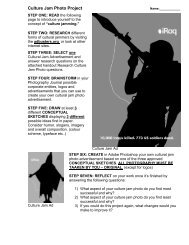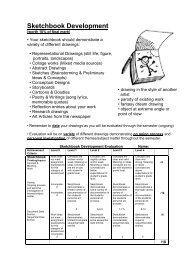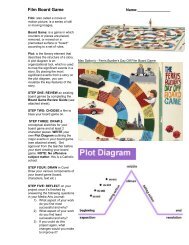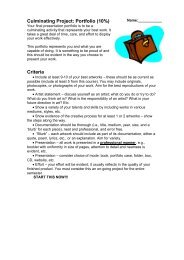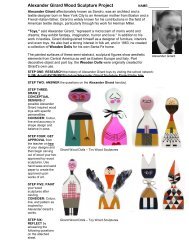AWQ 4M Culminating Project: Digital Portfolio (10%) Criteria
AWQ 4M Culminating Project: Digital Portfolio (10%) Criteria
AWQ 4M Culminating Project: Digital Portfolio (10%) Criteria
Create successful ePaper yourself
Turn your PDF publications into a flip-book with our unique Google optimized e-Paper software.
<strong>AWQ</strong> <strong>4M</strong> <strong>Culminating</strong> <strong>Project</strong>:<br />
<strong>Digital</strong> <strong>Portfolio</strong> (<strong>10%</strong>)<br />
Name:____________<br />
Your final presentation photography portfolio is to<br />
be a culminating activity that represents your best<br />
work. It takes a great deal of time, care, and effort to<br />
display your work effectively.<br />
This photography portfolio represents you and what<br />
you are capable of doing. It is something to be<br />
proud of and this should be evident in the way you<br />
choose to present your work.<br />
<strong>Criteria</strong><br />
• Include all the projects you have been working<br />
on all semester – these should be as current as<br />
possible.<br />
• Photographic Artist Statement – discuss yourself as a photographic artist; what<br />
do you do or try to do? What do you think art is? What is the responsibility of a<br />
photographer/artist? What is your future direction in photographic art? Etc.<br />
• Splash Page – The Splash page graphic should reflect either yourself or<br />
something about your unique photographic style.<br />
• Show a variety of your talents and skills by including a variety of works, black<br />
and white, styles, colour, etc.<br />
• Show evidence of the creative process for at least 1 or 2 works – show the<br />
steps along the way.<br />
• Effort – your effort will be evident; it usually reflects in the quality of your<br />
finished product. You must consider this an on-going project for the entire semester.<br />
START THIS NOW!!!<br />
• REFLECT: Answer the following questions using the elements and principles of<br />
design and complete your <strong>Portfolio</strong> for formal evaluation:<br />
1. What part of your finished portfolio did you find most successful and why?<br />
2. What part of your finished portfolio did you find least successful and why?<br />
3. If you had to do this portfolio, what part would you change or improve on and<br />
why?
<strong>AWQ</strong> <strong>4M</strong> - Photographic Arts <strong>Portfolio</strong> Evaluation<br />
Name:_______________<br />
Content /25<br />
Overall quality of photo art works included 0 2 4 6 8 10<br />
Splash page graphic(s) 0 1 2 3 4 5<br />
Button graphics<br />
0 1 2 3 4 5<br />
Evidence of the creative process (1-2) 0 1 2 3 4 5<br />
Documentation /15<br />
Artist’s Statement 1 2 3 4 5<br />
Spelling, mechanics 1 2 3 4 5<br />
Reflection Questions 1 2 3 4 5<br />
Layout and Presentation /15<br />
Professionalism 1 2 3 4 5<br />
Originality/Creativity 1 2 3 4 5<br />
Overall Effort 1 2 3 4 5<br />
TOTAL /55<br />
Comments/Next steps:
A1. The Creative Process: apply the creative process to create a variety of artworks, individually and/or collaboratively;<br />
A1. The Creative Process: apply the creative process to create a variety of artworks, individually and/or collaboratively;<br />
A1.1 use various strategies, individually and/or collaboratively, with increasing skill to generate, explore, and elaborate on original<br />
ideas and to develop, reflect on, and revise detailed plans for the creation of art works that address a variety of creative<br />
challenges (e.g., extend their skills in using brainstorming, concept webs, mind maps, and/or groups discussions to formulate<br />
original and innovative ideas for an art work on a social or personal theme; use critical research skills to explore and elaborate on<br />
ideas; demonstrate fluency in formulating clear and detailed plans; demonstrate flexibility in revising their plans on the basis of<br />
reflection)<br />
A1.2 apply, with increasing fluency and flexibility, the appropriate stages of the creative process to produce two- and threedimensional<br />
art works using a variety of traditional and contemporary media (e.g., extend their skills in working with a range of<br />
media; demonstrate flexibility in revising plans in response to problems encountered during other stages of the creative process;<br />
reflect on the effectiveness of preliminary versions of their work, and revise the work on the basis of reflection and selfassessment)<br />
A1.3 document their use of each stage of the creative process, and provide evidence of critical inquiry, in a portfolio that includes<br />
a range of art works created for a variety of purposes (e.g., ensure that their portfolio includes the following: evidence of critical<br />
inquiry associated with idea generation and elaboration; evidence of research on how different artists approach specific themes<br />
and/or use particular techniques that can be adapted in their own work; preliminary and final works to show evidence of<br />
thoughtful revision), and review and reflect on the contents of their portfolio to determine how effectively they have used the<br />
creative process<br />
A2. The Elements and Principles of Design: apply the elements and principles of design to create art works for the purpose of selfexpression<br />
and to communicate ideas, information, and/or messages;<br />
A2.1 apply the elements and principles of design with increasing skill and creativity to produce two- and three-dimensional art<br />
works that express personal feelings and communicate specific emotions<br />
A2.2 apply the elements and principles of design as well as a wide range of art-making conventions with increasing skill and<br />
creativity to produce art works that comment and/or communicate a clear point of view on a variety of issues (e.g., extend their<br />
skills by manipulating elements and principles and using conventions in creative ways to produce an art work that conveys the<br />
point of view of a teenager living on the street or that comments on a current event or social issue)<br />
A3. Production and Presentation: produce art works, using a variety of media/materials and traditional and emerging technologies,<br />
tools, and techniques, and demonstrate an understanding of a variety of ways of presenting their works and the works of others.<br />
A3.1 use with increasing skill a wide variety of media, including alternative media, and current technologies to create two- and<br />
three-dimensional art works for a variety of purposes<br />
A3.2 use with increasing skill a wide variety of traditional and current materials, technologies, techniques, and tools to create<br />
original art works for a variety of purposes and audiences<br />
A3.3 describe appropriate standards and conventionsfor the presentation of different types of visual art works, and apply these<br />
standards and conventions when preparing their art works for presentation<br />
B1. The Critical Analysis Process: demonstrate an understanding of the critical analysis process by examining, interpreting,<br />
evaluating, and reflecting on various art works;<br />
B1.2 deconstruct with increasing skill and insight the visual content and the use of elements and principles of design in their<br />
own art work and the work of others<br />
B1.4 describe in detail and reflect on with increasing insight the qualities of their art works and the works of others, and<br />
evaluate the effectiveness of these works using a wide variety of criteria<br />
C1. Terminology: demonstrate an understanding of, and use correct terminology when referring to, elements, principles, and other<br />
components related to visual arts;<br />
C1.1 extend their understanding of the elements and principles of design, and use terminology related to these elements<br />
and principles correctly and appropriately when creating or analysing a variety of art works (e.g., when analysing how<br />
artists’ manipulation of space, movement, form, and proportion affects meaning in an installation or an environmental<br />
work)<br />
C1.2 explain in detail terminology related to a wide variety of techniques, materials, and tools (e.g., techniques and materials<br />
associated with installation art; additive and subtractive techniques, digital manipulation, impasto, optical colour mixing,<br />
pointillism), and use this terminology correctly and appropriately when creating, analysing, and/or presenting art works<br />
C1.3 explain in detail the stages of the creative process and the critical analysis process, and explain, using appropriate<br />
terminology, how these processes contribute to the successful creation and analysis of art works<br />
C2. Conventions and Techniques: demonstrate an understanding of conventions and techniques used in the creation of visual art<br />
works;<br />
C2.1 extend their understanding of a wide variety of techniques that artists use to achieve a range of specific effects (e.g.,<br />
techniques used to create a range of textures in an art work, to develop the connection and relationship between forms in a<br />
composition, to draw attention to specific parts of a work)<br />
C2.2 extend their understanding of the variety of conventions used in visual art (e.g., allegory, appropriation, juxtaposition,<br />
synectics; conventions associated with formalism, objective and non-objective abstraction, propaganda, realism, social<br />
commentary), and explain in detail how they are used in a variety of art works<br />
C3. Responsible Practices: demonstrate an understanding of responsible practices in visual arts.<br />
C3.2 demonstrate appropriate health and safety procedures and conscientious practices in the selection and use of various<br />
materials, techniques, tools, and technologies when producing or presenting art works (e.g., demonstrate safe practices when<br />
creating installations, assemblages, earthworks, constructions, multimedia projects; demonstrate appropriate protocols,<br />
deportment, and respect for others when working in a studio or visiting a presentation space)


